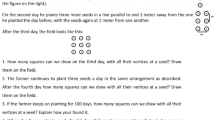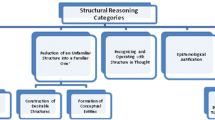Abstract
This study focuses on the generalization methods used by talented pre-algebra students in solving linear and non-linear pattern problems. A qualitative analysis of the solutions of three problems revealed two approaches to generalization: recursive–local and functional–global. The students showed mental flexibility, shifting smoothly between pictorial, verbal and numerical representations and abandoning additive solution approaches in favor of more effective multiplicative strategies. Three forms of reflection aided generalization: reflection on commonalities in the pattern sequence’s structure, reflection on the generalization method, and reflection on the “tentative generalization” through verification of the pattern sequence. The latter indicates an intuitive grasp of the mathematical power of generalization. The students’ generalizations evinced algebraic thinking in the discovery of variables, constants and their mutual relations, and in the communication of these discoveries using invented algebraic notation. This study confirms the centrality of generalizations in mathematics and their potential as gateways to the world of algebra.












Similar content being viewed by others
Notes
The club, which includes ∼400 students aged 10–16, was founded nine years ago by one of the authors of this paper. The project aimed at addressing the special needs of students (most of whom come from underdeveloped or struggling areas), who possess mathematical ability but are not necessarily considered gifted, and who are interested in and desirous of learning more about mathematics. The club and its activities are designed to help these children by developing their mathematical and creative thinking skills.
The students participate in weekly mathematics workshops in specific topics (such as logic, problem-solving, number theory, etc.), and attend a full day devoted to science and social activity every five weeks. Classes are taught by teachers rich in mathematical knowledge and very experienced in working with talented students—most from the former Soviet Union. The students come from 50 schools in 14 different cities and villages. Some leave the club after one year, but most remain for several years. In its 9 years of existence, Kidumatica has won a string of awards in national and international Olympiads, and its graduates have moved on to prestigious university faculties.
In a pilot study, the students were asked to provide “justifications” for their solution paths, a term that proved misleading and problematic. Students were not familiar with the request to justify in mathematics and associated the instruction only to verbal tasks such as in history or social studies. Some students were confused by the origin of the word “justification,” were unsure what it had to do with mathematics, and did not proceed. As a result, the wording was altered to "What did I do; why did I do it; if I changed my mind—why; if I did not answer—why.” These instructions guided the students in providing justifications without using explicit instructions.
Hanukah is a Jewish holiday on which we light candles on each day of the 8-day holiday. On the first day, two candles are lit (the leading candle and one additional candle); on the second day, three candles are lit (the leading candle and two additional candles); on the third day, four candles are lit (the leading candle and three additional candles); and so on, until the eighth and last day of celebration.
None of the students were familiar with the formula for the sum of arithmetic progression.
References
Amit, M., & Klass-Tsirulnikov, B. (2005). Paving a way to algebraic word problems using a nonalgebraic route. Mathematics Teaching in the Middle School, 10, 271–276.
Amit, M., & Burda, I. (2005). “Why do we learn mathematics? Because it organizes our minds” An encounter between former Soviet Union and Israeli cultures of mathematics education. Proceedings of the 57th conference of the international commission for the study and improvement of mathematical education (pp. 16–22). Palermo, Italy: Palermo University.
Amit, M., Fried, M., & Abu-Naja, M. (2007). The mathematics club for excellent students as common ground for Bedouin and other Israeli youth. In: B. Sriraman (Ed.), International perspectives on social justice in mathematics education, monograph 1, the montana mathematics enthusiast (pp. 75–90). The University of Montana Press: USA
Amit, M., & Neria, D. (2007). Assessing a modeling process of a linear pattern task. Paper presented at the 13th conference of the International Community of Teachers of Mathematical Modeling and Applications, IN, USA.
Bardini, C., Radford, L., & Sabena, C. (2005). Struggling with variables, parameters, and indeterminate objects or how to go insane in mathematics. In: H. L. Chick, J. L. Vincent (Eds.), Proceedings of the 29th conference of the international group for the psychology of mathematics education (Vol. 2, pp. 129–136). Melbourne, Australia: University of Melbourne.
Becker, J. R., & Rivera, F. (2004). An investigation of beginning algebra students’ ability to generalize linear patterns. In: M. J. Hoins, & A. B. Fuglestad (Eds.), Proceedings of the 28th conference of the international group for the psychology of mathematics education (Vol. 1, p. 286). Bergen, Norway: Bergen University College.
Dahl, B. (2004). Analysing cognitive learning process through group interviews of successful high school pupils: Development and use of a model. Educational Studies in Mathematics, 56, 129–155.
Davydov, V. V. (1990). Soviet studies in mathematics education. In: J. Kilpatrick (Ed.), & J. Teller (Trans.), Types of generalization in instruction: Logical and psychological problems in the structuring of school curricula. Reston, VA: National Council of Teachers of Mathematics (original work published in 1972).
Davis, R. B. (1986). Learning mathematics: The cognitive science approach to mathematics education (2nd ed.). Norwood, NJ: Ablex.
De Bock, D., van Dooren, W., Jannsens, D., & Verschaffel, L. (2002). Improper use of linear reasoning: An in-depth study of the nature and the irresistibility of secondary school students’ errors. Educational Studies in Mathematics, 50, 311–334.
Doerfler, W. (1991). Forms and means of generalization in mathematics. In: A. Bishop (Ed.), Mathematical knowledge: Its growth through teaching (pp. 63–85). Mahwah, NJ: Erlbaum.
Dreyfus, T. (1991). Advanced mathematical thinking processes. In: D. Tall (Ed.), Advanced mathematical thinking (pp. 25–41). Dordrecht, The Netherlands: Kluwer.
Dubinsky, E. (1991). Reflective abstraction in advanced mathematical thinking. In: D. Tall (Ed.), Advanced mathematical thinking (pp. 95–123). Dordrecht, The Netherlands: Kluwer.
Ebersbach, M., & Wilkening, F. (2007). Children’s intuitive mathematics: The development of knowledge about nonlinear growth. Child Development, 78, 296–308.
Ellis, A. B. (2007). Connections between generalizing and justifying: Students reasoning with linear relationships. Journal for Research in Mathematics Education, 38, 194–229.
English, L. D., & Warren, E. A. (1998). Introducing the variable through pattern exploration. The Mathematics teacher, 91, 166–170.
Fried, M. N., & Amit, M. (2003). Some reflections on mathematics classroom notebooks and their relationship to the public and private nature of student practices. Educational Studies in Mathematics, 53, 91–112.
Greenes, C. (1981). Identifying the gifted student in mathematics. Arithmetic Teacher, 28(6), 14–17.
Harel, G., & Tall, D. (1991). The general, the abstract and the generic in advanced mathematics. For the Learning of Mathematics, 11, 38–42. Retrieved from http://www.warwick.ac.uk/staff/David.Tall/pdfs/dot1991b-harel-flm.pdf.. Accepted 29 September 2007.
Ishida, J. (1997). The teaching of general solution methods to pattern finding problems through focusing on an evaluation and improvement process. School Science and Mathematics, 97, 155–162.
Kaput, J. J. (1999). Teaching and learning a new algebra. In E. Fennema, & T. A. Romberg (Eds.), Mathematics classrooms that promote understanding (pp. 133–155). Mahwah, NJ: Erlbaum.
Kerbs, A. S. (2003). Middle grade students’ algebraic understanding in a reform curriculum. School Science and Mathematics, 103, 233–243.
Koichu, B., & Berman, A. (2005), When do gifted high school students use geometry to solve geometry problems? Journal of Secondary Gifted Education, 16(4), 168–179.
Krutetskii, V. A. (1976). The psychology of mathematical abilities in schoolchildren. Chicago: University of Chicago Press.
Lanin, J. K., Barker, D. D., & Townsend, B. E. (2006). Recursive and explicit rules: How can we build student algebraic understanding? Journal of Mathematical Behavior, 25, 299–317.
Lee, L. (1996). An initiation into algebraic culture through generalization activities. In N. Bednarz, C. Kieran, & L. Lee (Eds.), Approaches to algebra: Perspectives for research and teaching (pp. 87–106). Dordrecht, The Netherlands: Kluwer.
Maher, C. A. (2002). How students structure their own investigations and educate us: What we’ve learned from a fourteen year study. In: A. D. Cockburn, & E. Nardi (Eds.), Proceedings of the 26th international group for the psychology of mathematics education (Vol. 1, pp. 31–46). Norwich, UK: University of East Anglia.
Mason, J. (1996). Expressing generality and roots of algebra. In: N. Bednarz, C. Kieran, & L. Lee (Eds.), Approaches to algebra: Perspectives for research and teaching (pp. 65–86). Dordrecht, The Netherlands: Kluwer.
Mitchelmore, M. C. (2002). The role of abstraction and generalization in the development of mathematical knowledge. ERIC document reproduction service no. ED 466 962. Retrieved from ERIC Web site: http://www.eric.ed.gov. Accepted 22 June 2006.
National Council of Teachers of Mathematics. (2000). Principals and standards for school mathematics. Reston, VA: National Council of Teachers of Mathematics.
Neria, D., & Amit, M. (2006). When the wrong answer is the “good” answer: Problem-solving as a means for identifying mathematical promise. In: J. Novotna, H. Moraova, M. Kratka, & N. Stehilkova (Eds.), Proceedings of the 30th conference of the international group for the psychology of mathematics education (Vol. 4, pp. 225–232). Prague, the Czech Republic: Charles University.
Orton, A., & Orton, J. (1999). Patterns and the approach to algebra. In: A. Orton (Ed.), Pattern in the teaching and learning of mathematics (pp. 104–120). London: Cassell.
Polya, G. (1957). How to solve it (2nd ed.). Princeton: Princeton University Press.
Radford, L. (2006). Algebraic thinking and the generalization of patterns: A semiotic perspective. In: S. Alatorre, J. L. Cortina, M. Sáiz, & A. Méndez (Eds.). Proceedings of the 28th annual meeting of the North American chapter of the international group for the psychology of mathematics education (Vol. 1, pp. 2–21). Mérida, México: Universidad Pedagógica Nacional.
Rivera, F. (2007). Visualizing as a mathematical way of knowing: Understanding figural generalization. Mathematics Teacher, 101(1), 69–75.
Rivera, F. D., & Becker, J. R. (2005). Figural and numerical modes of generalizing in algebra. Mathematics Teaching in the Middle School, 11(4), 198–203.
Skemp, R. R. (1986). The psychology of learning mathematics. NY: Penguin Books.
Sriraman, B. (2003). Mathematical giftedness, problem solving, and the ability to formulate generalizations: The problem-solving experiences of four gifted students. Journal of Secondary Gifted Education, 14, 151–165.
Sriraman, B. (2004). Reflective abstraction, uniframes and the formulation of generalizations. Journal of Mathematical Behavior, 23, 205–222.
Stacey, K. (1989). Finding and using patterns in linear generalizing problems. Educational Studies in Mathematics, 20, 147–164.
Steele, D. (2005). Using writing to access students’ schemata knowledge for algebraic thinking. School Science and Mathematics, 105, 142–154.
Sternberg, R. J. (1979). Human intelligence: Perspectives on its theory and measurement. Norwood, NJ: Ablex.
Swaford, J. O., & Langrall, C. W. (2000). Grade 6 students’ preinstructional use of equations to describe and represent problem situations. Educational Studies in Mathematics, 31, 89–112.
Usiskin, Z. (1988). Conceptions of school algebra and uses of variables. In: A. Coxford, & A. P. Schulte (Eds.), Ideas of algebra, K-12, 1988 Yearbook (pp. 8–19). Reston, VA: National Council of Teachers of Mathematics.
Warren, E. A., Cooper, T. J., & Lamb, J. T. (2006). Investigating functional thinking in the elementary classroom: Foundations of early algebraic reasoning. Journal of Mathematical Behavior, 25, 208–223.
Zazkis, R., & Liljedahl, P. (2002). Generalization of patterns: The tension between algebraic thinking and algebraic notation. Educational Studies in Mathematics, 49, 379–402.
Zareba, L. (2003). From research on the process of generalizing and on applying a letter symbol by pupils aged 10 to 14. In: Proceedings of the 55th conference of the international commission for the study and improvement of mathematics education, Plock, Poland, pp. 1–6.
Author information
Authors and Affiliations
Corresponding author
Rights and permissions
About this article
Cite this article
Amit, M., Neria, D. “Rising to the challenge”: using generalization in pattern problems to unearth the algebraic skills of talented pre-algebra students. ZDM Mathematics Education 40, 111–129 (2008). https://doi.org/10.1007/s11858-007-0069-5
Accepted:
Published:
Issue Date:
DOI: https://doi.org/10.1007/s11858-007-0069-5




